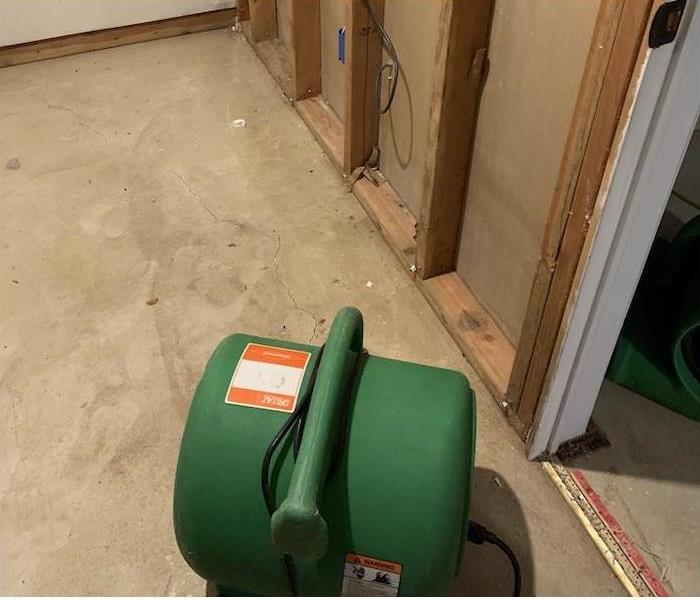Randolph Homes Need Professionals to Handle Water Damage
3/28/2023 (Permalink)
 When this Randolph home suffered water damage, we worked quickly to limit further damage and prevent mold growth.
When this Randolph home suffered water damage, we worked quickly to limit further damage and prevent mold growth.
How SERVPRO Technicians Accelerate Drying During Water Damage Remediation in Randolph?
The best way to control the extent of water damage to your Randolph home is to accelerate the drying process. SERVPRO technicians achieve this by creating conditions that favor drying.
Establishing a drying zone is one of the first things SERVPRO technicians do during the water damage restoration of your Randolph home. A drying zone is an area where the technicians control the humidity, airflow, and temperature to speed up the drying of wet materials. SERVPRO experts crate such a zone by sealing off openings between affected and unaffected areas by closing doors or erecting plastic sheeting (also called containment). Establishing drying zones allow the technicians to focus their equipment’s efforts; the smaller the drying zone, the better will be drying efficiency. Several rooms affected by water damage will be combined into a single drying zone to increase efficiency.
Positioning the Equipment
Establishing the drying zone is not enough to speed up the drying process. It is equally important to position the drying equipment properly within the area to increase the efficiency of the drying process. The two most essential pieces of equipment that SERVPRO technicians use in the zones are air movers and dehumidifiers.
- Positioning air movers: Before beginning the restoration work, the SERVPRO technicians determine how many air movers are needed to dry your Randolph home. Once the number of required air movers is known, the next decision is where to position them. Air movers are placed to blow air directly on the wet materials. The technicians ensure that adequate airflow is maintained. If multiple walls are dried in a room, the technicians position the air movers to create a vortex of circular airflow. To maintain the vortex, the restorers place air movers close to each wall and at an angle (15° angle for axial and 45° angle for centrifugal air movers).
- Positioning dehumidifiers: Dehumidifiers process the air within the drying zone to eliminate moisture. Simply placing the dehumidifiers in the drying zone is not enough; the technicians need to put them throughout the structure strategically. Ideally, at least one dehumidifier is placed in the room where water intrusion occurs. Other dehumidifiers are arranged to direct their exhaust towards wet materials such as saturated cabinets or wet hardwood flooring.
Controlled Demolition
According to the IICRC S500 guidelines, restorers must consider demolishing and removing structural materials if doing so can accelerate the drying process. If the technicians determine that structural demolition can expedite the drying process, they share the customer's information. SERVPRO technicians ensure that no demolition takes place without the customer's consent.
The demo step is not required if the water damage is limited to a small area and the water has not intruded into the structural components. Some of the structural elements that technicians might remove during water restoration of your Randolph home include:
- Carpets soaked with water
- Carpet pads
- Baseboard trim of drywalls
- Drilling holes in drywall to install wall cavity drying system
Water restoration is a complex process that involves carefully executed steps. Hiring an experienced restoration company like SERVPRO can help you limit the extent of the damage and reduce the restoration costs. We work hard to restore water damage to your home “Like it never even happened.”
To know more and speak with one of our experienced technicians, call SERVPRO of Southwest Morris County at (973) 895-5000; We’re Faster To Any Size Disaster.






 24/7 Emergency Service
24/7 Emergency Service